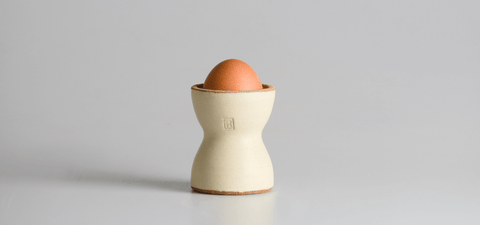There's a quiet beauty in the objects we use every day. A cup that fits perfectly in the hand, a well-balanced handle, an organic curve, a plate that highlights food, that makes a moment memorable.
We often take them for granted, but within those daily gestures there is an entire world: made of matter, choices, intentions.
Erra Ceramica was born from this very awareness. After years spent designing immaterial things (campaigns, brands, strategies), I felt the need to return to matter. Real earth, which molds, resists, teaches, and remembers every touch. Functional ceramics have become my way of slowing down, creating, and offering truly useful beauty.
It's not just about "making dishes." It's about designing experiences. About shaping the relationship we have with objects and with ourselves. A well-designed cup can hold much more than just coffee: it can hold attention, memory, and gesture.
In this article, I want to lead you into this world, made of clay and the wheel, but also of philosophy and care. Whether you're a ceramist, a designer, or simply a lover of well-crafted things, you might discover that your morning cuppa has much more to say than you think.
What is functional ceramic?
At first glance, it's the humblest of ceramics. A cup, a plate, a bowl. Objects that seem simple, almost invisible. It's the kind of folk pottery we find in our grandparents' country homes. Yet behind that simplicity lies one of the most profound and fascinating challenges: combining art with everyday life, beauty with utility.
When I talk about functional ceramics, I think of objects created to be truly used. Not just usable , but carefully designed to become part of a repeated gesture: drinking, serving, containing. Cups, plates, teapots, vases, jugs—familiar shapes, yes, but imbued with purpose.
For me, functionality is never a given. Every object must meet real needs: it must feel good in the hand, stand the test of time, be food-safe, and easy to clean. It must interact with everyday life.
The history of functional ceramics is our history
Functional clay objects are among humanity's oldest artifacts . As early as the Neolithic, humans were crafting vessels for cooking, storing, and offering. In every culture, tableware tells a story: what people ate, how they lived, and their relationship with the earth and fire.
From Chinese porcelain to Mediterranean terracotta, from Islamic majolica to Japanese yunomi cups, functional ceramics have always been part of our daily lives, and continue to be so today, even in a world saturated with plastic and industrial production.
Objects that listen
Functional ceramic isn't just comfortable or durable. It's intimate. It's close. It's that cup you always choose, because it "looks good." It's that plate that makes food more beautiful, without meaning to. It's a silent relationship, born over time and growing with use .
Every time I create an object intended for everyday use, I think about this: I'm not just shaping a material. I'm designing a gesture. A small moment. Something that will perhaps become part of your morning ritual, or your Sunday table setting.
Designing for the hands, not for a shop window
Functional ceramics are born from a conscious design process. Every curve, every edge, every handle is the result of a choice. The goal is not merely aesthetic: it is to create objects that are beautiful to look at and comfortable to use, capable of naturally accompanying everyday gestures.
Ergonomics and sensitivity of gesture
A mug may seem like a trivial object. But just picking it up is enough to understand if it's well thought out.
How much does it weigh? Is it balanced? Is the rim thin enough to make sipping comfortable? Does the handle grip easily, even with wet fingers?
These are simple but fundamental questions. That's where design begins. A functional object manages to disappear into the gesture. It doesn't impose, it accompanies.
The language of form
Shape is never neutral. A wide bowl invites, a narrow one protects heat. A spout can pour gracefully or drip everywhere. Every line, every detail tells a story and influences its use.
A thin rim invites a light contact with the lips.
A wide curve makes it easier to grip.
A stable base gives security on the table.
When functionality is well designed, it's not immediately obvious. But it's felt. In the body, in gesture, in experience.
Materials and surfaces: between technique and poetry
It's not just a matter of form but also of reliable materials. Resistant clays, like stoneware or porcelain, can withstand heat, washing, and microwaves. Tested and safe glazes that don't drip during firing, don't release chemicals, or crack.
But it's not just a technical matter. The surface also speaks volumes. A smooth satin texture adds softness. A rough finish evokes the feel of earth. A matte glaze warms. A glossy white makes food stand out. Every choice is also a narrative gesture.
Technical note:
Enamels intended for functional use must be safe, stable, and durable. They must not release harmful substances or be altered by contact with liquids or acids. The ceramic body and the glaze must be compatible to avoid cracking and detachment over time.
Experience, not just an object
When form, function, material, and surface find balance, an object ceases to be just an object. It becomes something that accompanies, that endures. A cup you always choose. A plate that, quite simply, "is home."
Behind every object, a hidden challenge
Making functional ceramics isn't just about crafting something beautiful. It means making it work, withstanding daily use, and ensuring safety. Each object is a small engineering project, where materials, form, and chemistry must interact harmoniously. It doesn't take much to disrupt this balance. Sometimes, literally.
1. Food safety
One of the greatest responsibilities concerns contact with food and drink. No beauty is worth the risk of contamination.
For this reason it is essential:
- use safe nail polishes, free from soluble or potentially toxic substances (such as excess copper or barium),
- balance the ceramic body and enamel well to avoid invisible fractures that can harbor bacteria or cause breakages,
- test absorption and leaching accurately.
Technical curiosity:
Even a seemingly perfect nail polish can, over time, release metals. The classic lemon juice test is a useful first step, but laboratory testing is necessary for real certainty.
2. Fire and its unknowns
The oven is a powerful ally, but also unpredictable. The temperature, the firing curve, the internal atmosphere, even the positioning of a piece can change everything.
Common problems?
- Enamels that drip and ruin the work (and the oven shelf),
- Crazing: microfractures in the enamel that weaken the surface,
- Colors that change from expected due to temperature changes or unexpected chemical reactions.
Helpful tip:
Document every step, every test. Write everything down. The test notebook is an irreplaceable tool.
3. Repeat consistently
Making a beautiful mug is a challenge. Making it ten times identical is even more complex. Weight, thickness, balance, glaze tone: every detail can vary.
Small differences in materials, air humidity, the consistency of the glaze, or the gesture itself can produce different results. And every variation is visible and felt.
4. Finding the balance between form and content
There's another, more subtle challenge: being able to express a personal vision without losing sight of function. A handle can be beautiful, but if you can't grip it well, it's useless. Enamel can have an extraordinary color, but if it's unstable, it's best avoided for tableware.
This is where the most fascinating challenge lies. Finding a voice, a unique signature, while remaining faithful to the idea that the object should live in everyday life. Not on a shelf. But in our hands.
Why functional ceramics give deep satisfaction
There's something special, almost invisible yet powerful, in creating an object that will be used every day. Not displayed on a shelf, but within someone's life. Functional ceramics is a silent art, tied to gestures, rhythms, and habits.
The intimacy of everyday use
A handmade cup can become the morning cup, the one you look for even before you open your eyes. A plate can become part of a ritual, or a memory.
These objects become part of our everyday lives. They inhabit it. And over time, they build bonds.
For me, knowing that something I've created becomes important to someone is one of the true joys of this job.
An antidote to mass production
We're surrounded by anonymous objects, made to last a short time and say even less. Artisanal ceramics, on the other hand, is a counter-current gesture. A way to slow down, choose, and value.
Each piece tells a story.
Every imperfection is a signature.
Each object is unique, unrepeatable.
Choosing a handmade object also means choosing how to inhabit our everyday spaces. Awareness is key.
A growth path
Working with ceramics every day is also a way to get to know yourself better. The material doesn't lie: it reveals limits, tests patience, and teaches the importance of observing before acting.
Every object born is the result of a series of choices, adjustments, and sometimes compromises. Some lessons come with time, others with mistakes that burn (in the oven and inside :). But in all of this, there's a sense of continuous progress, never linear, always alive.
This is what keeps the desire to do alive.
The joy of something that works
When everything comes together: the shape, the weight, the glaze, the chemistry... an object is born that truly works. And this achievement brings with it a simple, profound joy. The satisfaction of a gesture well done.
It's a quiet pride. The pride of having created something useful, beautiful, and profoundly human.
Conclusion – The silent beauty of useful things
Functional ceramics is a discreet art. It doesn't need to attract attention. It doesn't shout, it doesn't impose itself. It enters people's homes quietly and, unnoticed, remains there. Every time someone pours a coffee, picks up a spoon, heats a soup, the ceramist's hand is there. Invisible, but present.
In a fast-paced, digital, and often disembodied age, modeling objects for real life is a counter-current. It's a way to return to the material, to the right timing of the hands, to the value of small gestures. And, above all, to the other. To those who will use that object, perhaps without ever knowing who made it.
Creating functional ceramics is an act of love. A tangible love, tested through fire, made to last.
An invitation
Look at the objects you use every day. The ones you truly love have a story. Perhaps a shape that reassures you, a surface you enjoy touching.
Perhaps, even without knowing it, they were made by hand.
And maybe you could do them too.
If you feel that even simple things deserve attention, I invite you to observe, touch, and use them more consciously. And to ask yourself: what would it be like if every object were made with care?
Are you curious to discover what it means to create with your own hands? In my studio, I hold courses and workshops designed to introduce you to functional ceramics in a practical, simple, and personal way.
No experience is required, just a willingness to listen to the material, the gesture, the time.

